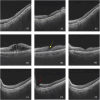Assessment of synthetic post-therapeutic OCT images using the generative adversarial network in patients with macular edema secondary to retinal vein occlusion
- PMID: 40535568
- PMCID: PMC12174594
- DOI: 10.3389/fcell.2025.1609567
Assessment of synthetic post-therapeutic OCT images using the generative adversarial network in patients with macular edema secondary to retinal vein occlusion
Abstract
Aims: The aim of this study is to generate post-therapeutic optical coherence tomography (OCT) images based on pre-therapeutic OCT by using generative adversarial networks (GANs). The synthetic images enable us to predict the short-term therapeutic efficacy of intravitreal injection of anti-vascular endothelial growth factor (VEGF) in retinal vein occlusion (RVO) patients.
Methods: The study involved patients with RVO who received intravitreal anti-VEGF injection from 1 November 2018 to 30 November 2019. The OCT images taken before and shortly after treatment, with an interval of 4-8 weeks, were collected and randomly divided into the training set and test set at a ratio of approximately 3:1. The model is constructed based on the pix2pixHD algorithm, and synthetic OCT images are evaluated in terms of the picture quality, authenticity, the central retinal thickness (CRT), the maximal retinal thickness, the area of intraretinal cystoid fluid (IRC), and the area of subretinal fluid (SRF). Three supporting models, namely, the macular detection model, retinal stratification model, and lesion detection model, were constructed. Segmentation of macular location, retinal structure, and typical lesions were added to the input information. After verifying their accuracy, supporting models were used to detect the CRT, the maximal retinal thickness, IRC area, and SRF area of synthetic OCT images. The output predictive values are compared with real data according to the annotation on the real post-therapeutic OCT images.
Results: A total of 1,140 pairs of pre- and post-therapeutic OCT images obtained from 95 RVO eyes were included in the study, and 374 images were annotated. Of the synthetic images, 88% were considered to be qualified. The accuracy of discrimination of real versus synthetic OCT images was 0.56 and 0.44 for two retinal specialists, respectively. The accuracy to predict the treatment efficacy of CRT, the maximal retinal thickness, IRC area, and SRF area was 0.70, 0.70, 0.92, and 0.78, respectively.
Conclusion: Our study proves that the GAN is a reliable tool to predict the therapeutic efficacy of anti-VEGF injections in RVO patients. Evaluations conducted both qualitatively and quantitatively indicated that our model can generate high-quality post-therapeutic OCT images. Consequently, it has great potential in predicting the treatment efficacy and providing guidance to clinical decision-making.
Keywords: anti-vascular endothelial growth factor; generative adversarial networks; optical coherent tomography; retinal vein occlusion; therapeutic efficacy prediction.
Copyright © 2025 Feng, Yang, Zhao, Zhao, Du, Yu, Ding, Li and Chen.
Conflict of interest statement
Authors JZ, YD and DD were employed by company Visionary Intelligence Ltd. The remaining authors declare that the research was conducted in the absence of any commercial or financial relationships that could be construed as a potential conflict of interest.
Figures






Similar articles
-
Stable and discriminating OCT-derived radiomics features for predicting anti-VEGF treatment response in diabetic macular edema.Med Phys. 2025 May;52(5):2762-2772. doi: 10.1002/mp.17695. Epub 2025 Mar 14. Med Phys. 2025. PMID: 40085126 Free PMC article.
-
Risk factors and incidence of Macular Edema in eyes with retinal Vein Occlusion after uneventful cataract surgery: The MEVO study.Indian J Ophthalmol. 2025 Jun 1;73(6):864-869. doi: 10.4103/IJO.IJO_1700_24. Epub 2025 Apr 17. Indian J Ophthalmol. 2025. PMID: 40243070 Free PMC article.
-
Short and long-term impact of intravitreal anti-VEGF therapy interruption in retinal vein occlusion during the COVID-19 pandemic: functional outcomes and AI-based fluid analysis of macular edema.Int J Retina Vitreous. 2025 Aug 5;11(1):92. doi: 10.1186/s40942-025-00717-x. Int J Retina Vitreous. 2025. PMID: 40765020 Free PMC article.
-
Emerging applications of bioinformatics and artificial intelligence in the analysis of biofluid markers involved in retinal occlusive diseases: a systematic review.Graefes Arch Clin Exp Ophthalmol. 2023 Feb;261(2):317-336. doi: 10.1007/s00417-022-05769-5. Epub 2022 Aug 4. Graefes Arch Clin Exp Ophthalmol. 2023. PMID: 35925451
-
Animal Models of Retinal Vein Occlusion.Invest Ophthalmol Vis Sci. 2017 Dec 1;58(14):6175-6192. doi: 10.1167/iovs.17-22788. Invest Ophthalmol Vis Sci. 2017. PMID: 29222552
Cited by
-
Multimodal reasoning agent for enhanced ophthalmic decision-making: a preliminary real-world clinical validation.Front Cell Dev Biol. 2025 Jul 23;13:1642539. doi: 10.3389/fcell.2025.1642539. eCollection 2025. Front Cell Dev Biol. 2025. PMID: 40772224 Free PMC article.
References
-
- Costa J. V., Moura-Coelho N., Abreu A. C., Neves P., Ornelas M., Furtado M. J. (2021). Macular edema secondary to retinal vein occlusion in a real-life setting: a multicenter, nationwide, 3-year follow-up study. Graefes. Arch. Clin. Exp. Ophthalmol. 259 (2), 343–350. 10.1007/s00417-020-04932-0 - DOI - PubMed
-
- Horozoglu F., Sener H., Polat O. A., Temizyurek O., Evereklioglu C. (2023). Predictive impact of optical coherence tomography biomarkers in anti-vascular endothelial growth factor resistant macular edema treated with dexamethasone implant. Photodiagnosis Photodyn. Ther. 42, 103167. 10.1016/j.pdpdt.2022.103167 - DOI - PubMed
LinkOut - more resources
Full Text Sources
Research Materials
Miscellaneous

